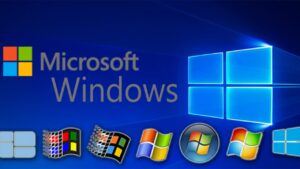Microsoft Windows is a widely used operating system developed by Microsoft, powering millions of computers globally. It is available in several different versions, including Windows 10, 8, and 7, catering to both personal and professional computing needs.
Overview of Microsoft Windows
Microsoft Windows stands out with its user-friendly interface, ensuring effortless usability for users at any skill level. It also comes with a wide range of built-in tools and apps, including a web browser, media player, and productivity software, making it a comprehensive solution for both personal and professional use.

It is also highly customizable, allowing individuals to personalize the look and feel of their operating system by changing the desktop background, screen saver, and other visual settings. It also supports a wide range of third-party software, enabling enhanced functionality as needed.
One of the main advantages of using these is its compatibility with a wide range of hardware and software. It can run on a variety of devices, including desktop computers, laptops, tablets, and even smartphones. It is also compatible with a large number of software programs, making it easy to use for a wide range of tasks.
In terms of security, It includes several built-in features to protect against viruses, malware, and other online threats. It also offers frequent updates to fix any vulnerabilities and improve overall performance.
How User-friendly is it?
Microsoft Windows is reputed for its user-friendly interface, which caters to the needs of individuals of all proficiency levels. Its intuitive design and straightforward navigation empower users to accomplish tasks efficiently.
With a plethora of built-in tools and applications, such as web browsers and productivity software, It simplifies daily computing activities.
Furthermore, its customizable features allow users to effortlessly tailor their experience to suit individual preferences. While challenges may sometimes arise, such as compatibility issues or forced updates, It strives to provide a user-friendly environment through constant updates and improvements.
Overall, MS excels at delivering a user-centric operating system that prioritizes ease of use and accessibility for all users.
Microsoft Windows excels in providing a user-friendly environment through several key attributes:
- Intuitive Interface: It features an intuitive user interface with easily recognizable icons, menus, and navigation tools. This design ensures that users can navigate the system effortlessly, whether they are accessing basic functionalities or advanced settings.
- Accessibility Features: The operating system includes various accessibility features, such as a magnifier, narrator, and speech recognition. These tools enhance usability for individuals with disabilities, promoting inclusivity and ensuring a user-friendly experience for all.
- Familiarity and Consistency: It maintains consistency across its versions, allowing individuals to transition smoothly between different iterations. This continuity minimizes the learning curve for new users and ensures a familiar computing environment regardless of the device or edition used.
- Help and Support Resources: It offers extensive help and support resources for Windows users, including built-in tutorials, online documentation, and community forums. These resources assist users in troubleshooting issues, mastering the system, and staying updated with the latest features and improvements.
- Customization Options: It provides robust customization options, enabling individuals to personalize their desktop environment, settings, and preferences. From changing desktop backgrounds to configuring screen savers and visual themes, users can tailor Windows to suit their individual needs and aesthetic preferences.
- Integration with Microsoft Ecosystem: It seamlessly integrates with other Microsoft products and services, such as Office 365, OneDrive, and Microsoft Edge. This integration enhances productivity and provides a cohesive user experience across devices and applications.
- Compatibility with Hardware and Software: It supports a vast ecosystem of hardware devices, peripherals, and software applications. It runs efficiently on desktop computers, laptops, tablets, and smartphones, accommodating diverse user preferences and computing requirements.
Pros and Cons of Microsoft Windows

Pros:
- User-friendly Interface: It offers an intuitive interface that facilitates easy navigation and use for users of all proficiency levels.
- Comprehensive Built-in Tools: It includes a wide range of built-in tools and apps, making it a complete solution for various personal and professional tasks.
- Customization Flexibility: Individuals can personalize their Windows experience extensively, from visual settings to system configurations, enhancing usability and satisfaction.
- Broad Compatibility: It is compatible with a vast array of hardware and software, ensuring versatility and flexibility in computing choices.
- Strong Security Measures: It incorporates robust security features to protect against viruses, malware, and online threats, with regular updates to enhance system resilience.
Cons:
- Cost: Some versions of Windows, especially enterprise editions, can be costly to license, impacting accessibility for budget-conscious users.
- Compatibility Challenges: Older software or hardware may face compatibility issues with newer versions, requiring updates or replacements.
- Security Vulnerabilities: Despite proactive security measures, It may be susceptible to vulnerabilities that necessitate prompt updates and vigilance.
- Bloatware: Certain versions of Windows come with pre-installed software (bloatware) that may not be essential, potentially consuming system resources and space.
- Forced Updates: Windows 10, in particular, is known for automatic updates, which while beneficial for security and performance, can disrupt user workflow if not managed properly.
Conclusion
Microsoft Windows stands out as a user-friendly operating system that combines intuitive design, comprehensive features, and extensive customization options. It caters to a broad spectrum of individuals, from casual home users to enterprise professionals, fostering productivity and innovation across diverse computing environments.
By leveraging its strengths in usability, compatibility, and support infrastructure, it continues to be a preferred choice for millions worldwide, supporting everyday tasks, creative endeavors, and business operations alike.
Also Read: What is iOS and How seamless is it?



